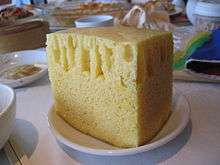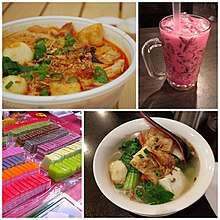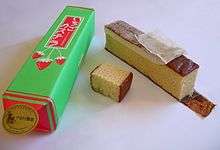Malay sponge cake
Malay sponge cake, also called ma lai go (Chinese: 馬來糕; pinyin: mǎláigāo; Jyutping: maa5 laai1 gou1) or ma la go (Chinese: 馬拉糕; pinyin: mǎlāgāo; Jyutping: maa5 loi4 gou1), is a kind of dessert which is very popular in Guangdong and Hong Kong in China. It usually can be seen at a traditional teahouse in Guangdong and Hong Kong. Traditional Malay sponge cake is made up of lard or butter, flour, and eggs, by using bamboo steamer to give puffiness. An entire Malay sponge cake is a huge yellow round cake, but is generally sold as slices in teahouses. There are many ways to make a Malay sponge cake, but in general, the taste should be very soft, sweet and chewy.
 Malay sponge cake at a Cantonese restaurant | |
| Alternative names | Ma lai go, ma la go, Malay cake, and others |
|---|---|
| Course | Dim sum, xiaochi |
| Place of origin | China, Malaysia |
| Region or state | Guangdong (Guangzhou, Hong Kong) |
| Main ingredients | Traditionally made with levain, flour, white sugar and eggs |
The historical boost of Malay sponge cake
There are three main hypotheses about Malay sponge cake's area of origin. The first one is that Malay sponge cake comes from Guangdong in China and was then brought to Malaysia through the second Chinese immigration wave in Malaya history during the British-ruled period.[1] The second hypothesis is that Malay sponge cake has developed from a British dessert and was then taken back to China by Chinese immigration.[2] The third hypothesis is that Malay sponge cake was developed from Castile cake, which was brought by Portuguese sailors to the Nanyang region and then back to China by an early immigrant from Guangdong province.[3][4]
From Guangdong to Malaysia

From the early 1930s, thousands of Chinese immigrants came to Malaya during the British-ruled period while trying to escape the poverty in China.[1] This was the second Chinese immigration wave in Malaya history and was also considered the most enormous influx of immigration to Malaysia.[1] Most of the Chinese immigration during that time came from Fujian and Guangdong provinces in the south-east coast of China. This largest immigration population brought with it various dialects and cultures, such as Cantonese and Cantonese cuisine, into Malaysia and thus laid the foundation for the cultural diversity of Malaysia today.[1] Malaysia today is a multicultural country, and their food culture is deeply influenced by multiculturalism. Malaysian cuisines are diverse and include features brought by immigrants from different countries.[5] In Malaysia, tourists can find various foods from all over the world, and Chinese food is probably most varied in Malaysia. Malay sponge cake and other foods, such as Bah Kut Teh, are also popular in Malaysia.[6] Therefore, it is reasonable to consider that Malay sponge cake came from Guangdong in China and then brought to Malaysia.
From Malaysia to China

In the British Malaysian era, English colonists still retained the habit of drinking afternoon tea with cake.[2] However, because the ingredients (like milk) and cooking props (like ovens) that Westerners used were not common in Malaysia[2], locals used coconut milk and steamers instead and made a different version of the English cake, which is the Malay sponge cake.[2] During the British Malaysian era, there were many immigrants from Guangdong province who were frequently travelling between Malaysia and mainland China.[1] It is also reasonable that Malay sponge cake was popular in English cuisine and was then brought back to China by Chinese immigration at that time.
From Portugal to China
The sponge cake came from West to East in the 16-17 century. In the mid-16th century, Portugal was also one of the world's leading maritime trading powers.[7] Many minor nobles and non-eldest sons of the urban bourgeoisie would set sail on ships and attempt to get rich anywhere in Brazil, Africa, India, or the South Pacific,[7] and the new Castilla bread was brought aboard. Sponge cakes last longer because they are dehydrated, compared to many noble foods that were complicated to make and difficult to preserve, and were a valuable and tasteful enjoyment for the food shortage of the far sea travel.[7] At that time, the Malacca base in the Nanyang region was fairly secure for the Portuguese.[8] Numerous merchant ships from Europe and Asia were often spotted there, allowing more Asians to come into contact with sponge cakes, and giving them experience to master the craft. The early immigrants from Guangdong to the south of the ocean accounted for many of these bakers.[7][4] In traditional Chinese cuisine however, there were no western baking skills. Therefore, producers at that time often steamed buns in the traditional way.[9] Although the ingredients were still flour, eggs, and butter from Europe, the result was more like steamed bread than cake. This unusual strange food was given the title "Malay cake" after it was introduced in Guangdong during the late Qing dynasty. Later, a more local version of lard or butter replaced the original butter and became a Cantonese tea classic, "Malay sponge cake".[4]
Hong Kong’s National Cake

Malay sponge cake is one of the most popular cakes in Hong Kong.[10] Malay sponge cake has even been considered Hong Kong's national cake by CNN.[10] The high status of Malay sponge cake in Hong Kong's dessert world could be compared to Lamington in Australia and Pavlova in New Zealand. The Lin Heung Teahouse, located on Wellington Street in Central, Hong Kong, serves an authentic version of Malay sponge cake, along with other notable, traditional Hong Kong cakes.[10]
Ingredients
There are several approaches to make Malay sponge cake with different tastes. There is the traditional approach[2], as well as some special approaches (e.g., Brown sugar and Coconut milk flavored Malay sponge cake[11] and Honey flavoured Malay sponge cake[12]).
Malay sponge cake is traditionally made with levain, flour, white sugar and eggs. Levain (also called "Lao mian" in Chinese) is usually made with water, beer, and flour. One variant of Malay sponge cake is using brown sugar instead of white sugar.[11] Using coconut milk to replace milk is also a variant in making Malay sponge cake.[11] More modern innovations include honey.[12]
Serving
Traditionally, Malay Sponge Cake is a kind of dim sum (à la carte item) or "xiaochi" (snack). The cakes are served hot in the bamboo baskets in which they were steamed, usually on a bed of dried leaves or paper mat.[2] Around Guangdong, Malay sponge cake is usually served as a dish during traditional Cantonese tea time.[2] Today Malaysian sponge cakes can be made into frozen foods and sold around the world.
Historical origins and similar varieties around the world

Malay sponge cake is one kind of sponge cake. The simple sponge cake is also a base for many different cake recipes around the world.[3] Around the mid-16th century, Paravicini, a Genoa nobleman, lived in Spain. Jobata, the pastry chef who stayed with him in Iberia, developed the world's first sponge cake at the palace in Madrid[7], making Spaniards the first to invent the sponge cake. The technique was then introduced to Italy and was known as pan di Spagna.[7] At that time, the Italians were already at the forefront of the Christian European world in terms of diet.[7] The republic of Genoa, whose main sources of income were navigation and banking, were not short of money.[7] Local aristocrats were keen to recruit highly skilled pastry chefs to craft better food for themselves. Since the republic's bankers mainly lent to the king of Spain, there was a representative in Madrid to keep them in touch, and urged the Spaniards to send more American silver to the vaults of Genoa, to keep large sums of capital flowing.[7] As a result, a new type of cake, apparently developed by the Italians, began to spread as the "Castella bread" celebrity.[7] These included the kingdom of Portugal to the west of the peninsula.[7] Then, with the development of the great age of navigation, the Castella bread became popular throughout Europe and among other western countries.[7]
After early sponge cakes were introduced to Europe for a period of time, several different kinds of cakes based on sponge cakes developed in Europe and other western countries.[3] For example, the cassata in France, the cream-filled cake in Italy, Victorian sponge in England, Frog cake in Australia, and Swiss roll in Switzerland.[3] Also, in America, people changed transitional sponge cake into egg-white-only style which was called angel food and further developed into chiffon, an oil-based style.[3] These can be seen as distant western relatives of Malay sponge cake, due to the sponge cake travel from West to East. Malay sponge cake has closer relatives in Asia as well.[3]
The Nagasaki cake is one of the famous cousins of Malay sponge cake in Japan. In the mid-16th century, Portugal was one of the world's leading maritime trading powers, and often brought Castella cakes aboard their ships.[7] During their conquests, however, Portugal did not have large silver deposits like the Spanish held in the Americas.[8] Fortunately, they found the Japanese islands in the far East and the largest silver deposit in the world, Ishiyama mountain.[8] Through negotiation and trade, the Portuguese acquired a fishing village near Nagasaki in 1571 as a place to stay.[8] By 1580, the Portuguese were officially granted the right to govern the area and formed the Nagasaki free city, similar to Macau.[8] Many Portuguese from Malacca, en route to Macao and Nagasaki, simply settled in the locale.[8]
Castella bread, which originally entered Japan in small quantities, began to be made on the shores of the far East. Japanese chefs employed by the Portuguese were the first to make Nagasaki cakes.[8] After the establishment of the Tokugawa shogunate, Nagasaki cake began to change.[8] To suit local tastes, pastry chefs added sugar to their recipes.[8] As sugar was not yet a cheap condiment, this popular food, originally introduced by sailors, gradually developed into an aristocratic food.[8] Localised flavorings, such as matcha and brown sugar, have also been gradually added to Nagasaki cake recipes.[8] At this point, Nagasaki cake has largely broken away from the original "Castella bread" and become an independent cake.[8] However, when the sponge cake known as "Castella bread" spread east, it wasn't Japan that landed first. In the Nanyang region at the time, the Portuguese Malacca base was far more secure than Nagasaki free city.[4] Numerous merchant ships from Europe and Asia were often spotted there. More Asians came into contact with sponge cakes and mastered the craft.[4] The early immigrants from Guangdong to the south of the ocean were of them.[4] However, in traditional Chinese cuisine, baking did not exist.[9] As a result, producers often steamed and cooked buns.[9] Although the ingredients were still flour, eggs, and butter from Europe, the result was more like steamed bread than cake. This unusual strange food, in the late Qing dynasty, was introduced into Guangdong, and was named "Malay cake".[4] Today, the Malay sponge cake can be seen as a cousin of the Japanese Nagasaki cake. Not only Japan, but other Asian countries also took the recipe and created their native cake styles[3]; for example, the chrysanthemum steamed lemon cake in Korean and milk sponge cake in Sri Lanka.[3]
References
- Ting, Chew-Peh (1982). Chinese Immigration and the Growth of a Plural Society in Peninsular Malaysia. United States: Research in Race and Ethnic Relations. pp. 103–123.
- Michelin Guide Digital-Singapore (2018). "Recipe: Traditional Ma Lai Gao". Michelin Guide Digital-Singapore.
- Castella, Krystina (2012). A World of Cake: 150 Recipes for Sweet Traditions from Cultures Near and Far; Honey cakes to flat cakes, fritters to chiffons, tartes to tortes, meringues to mooncakes, fruit cakes to spice cakes. Storey Publishing. p. 134. ISBN 9781603424462.
- Jacques de, Coutre (2014). The Memoirs and Memorials of Jacques de Coutre : Security, Trade and Society in 16th- and 17th-Century Southeast Asia . Singapore : NUS Press.
- Melissa, Perry (2017). "Feasting on Culture and Identity: Food Functions in a Multicultural and Transcultural Malaysia". Universiti Kebangsaan Malaysia. 23: 184–199 – via Social Science Premium Collection.
- Wong, Penny (2019). "Chinese Food in Malaysia". malaysia-hotels.
- Cynthia Clark, Northrup (2005). Encyclopedia of World Trade : from Ancient Times to the Present . New York: Armonk, NY: Sharpe Reference.
- Charles Ralph, Boxer (2011). The affair of the "Madre de Deus" : a chapter in the history of the Portuguese in Japan. London: London : Routledge. ISBN 9780203842652.
- Thomas O, Höllmann (2013). The Land of the Five Flavors : A Cultural History of Chinese Cuisine . New York: New York, NY : Columbia University Press.
- Li & Wong, Zoe & Maggie Hiufu (2017). "Cakes of the world: Tiramisu, baklava, cheesecake and more national treats". CNN travel.
- Goh, Helen (2018). "Steamed brown sugar and coconut milk cake (Ma Lai Gao)". goodfood.
- Lim, Celia (2015). "MA LAI GAO – EVEN SOFTER, FLUFFIER & TASTIER!". foodelicacy.